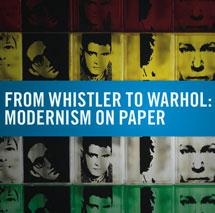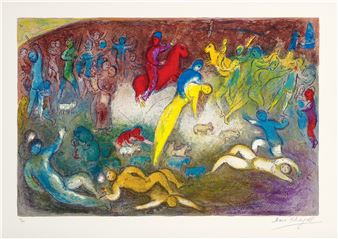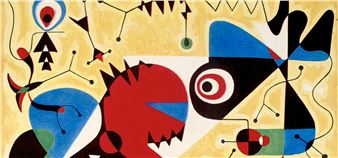From Whistler to Warhol: Modernism on Paper
Beginning with the American painter-printmaker James McNeill Whistler, the exhibition traces the history of modernism on paper to show how this technically variable, readily portable, and easily disseminated medium proved supremely adaptable to the avant-garde spirit of experimentation. It shows how Whistler pushed the limits of etching to elevate its status to that of painting, and how his lead was followed by many of his European contemporaries—among them the impressionists Camille Pissarro and Edgar Degas; and the symbolists Odilon Redon, Edvard Munch, and Paul Gauguin—all of whom likewise took printmaking beyond its illustrative function. They also asserted drawing as a primary medium, establishing the graphic arts—printing and drawing—as independent modes of expression.
The exhibition continues into the early 20th century, when the cubists Pablo Picasso and Georges Braque, the German expressionists Emile Nolde and Käthe Kollwitz, the surrealists Max Ernst and Joan Miró, and the American modernists John Marin and Joseph Stella exploited the blank page as a tabula rasa for new ideas both artistic and political. Special focus is given to American printmaking of the first half of the 20th century, when artists such as Edward Hopper, John Sloan, Raphael Soyer, and Thomas Hart Benton mastered etching and lithography as vehicles for conveying their fascination with the dynamism of the city and the quiet toil of rural life.
The exhibition continues into the mid-20th century, when the realism of the American Scene was supplanted by the abstraction of the internationalist New York School, whose revolution in painting found a counterpart in the innovations in printmaking achieved by many Abstract Expressionist artists. And it culminates with the 1960s and 1970s, when master printers such as Tatanya Grossman and June Wayne set up collaborative workshops where artists such as Jasper Johns, Ellsworth Kelly, Roy Lichtenstein, Robert Rauschenberg, and Frank Stella created screenprints and lithographs that took printmaking into the largely uncharted territory of photomechanic processes. Many of these artists—among them Sam Francis and Andy Warhol—set up print workshops of their own, asserting the centrality of printmaking to their studio practice.
The exhibition is organized by the Honolulu Academy of Arts and curated by Theresa Papanikolas, curator of European and American art.

Recommended for you
Beginning with the American painter-printmaker James McNeill Whistler, the exhibition traces the history of modernism on paper to show how this technically variable, readily portable, and easily disseminated medium proved supremely adaptable to the avant-garde spirit of experimentation. It shows how Whistler pushed the limits of etching to elevate its status to that of painting, and how his lead was followed by many of his European contemporaries—among them the impressionists Camille Pissarro and Edgar Degas; and the symbolists Odilon Redon, Edvard Munch, and Paul Gauguin—all of whom likewise took printmaking beyond its illustrative function. They also asserted drawing as a primary medium, establishing the graphic arts—printing and drawing—as independent modes of expression.
The exhibition continues into the early 20th century, when the cubists Pablo Picasso and Georges Braque, the German expressionists Emile Nolde and Käthe Kollwitz, the surrealists Max Ernst and Joan Miró, and the American modernists John Marin and Joseph Stella exploited the blank page as a tabula rasa for new ideas both artistic and political. Special focus is given to American printmaking of the first half of the 20th century, when artists such as Edward Hopper, John Sloan, Raphael Soyer, and Thomas Hart Benton mastered etching and lithography as vehicles for conveying their fascination with the dynamism of the city and the quiet toil of rural life.
The exhibition continues into the mid-20th century, when the realism of the American Scene was supplanted by the abstraction of the internationalist New York School, whose revolution in painting found a counterpart in the innovations in printmaking achieved by many Abstract Expressionist artists. And it culminates with the 1960s and 1970s, when master printers such as Tatanya Grossman and June Wayne set up collaborative workshops where artists such as Jasper Johns, Ellsworth Kelly, Roy Lichtenstein, Robert Rauschenberg, and Frank Stella created screenprints and lithographs that took printmaking into the largely uncharted territory of photomechanic processes. Many of these artists—among them Sam Francis and Andy Warhol—set up print workshops of their own, asserting the centrality of printmaking to their studio practice.
The exhibition is organized by the Honolulu Academy of Arts and curated by Theresa Papanikolas, curator of European and American art.
Artists on show
- Andy Warhol
- Camille Pissarro
- Edgar Degas
- Edvard Munch
- Edward Hopper
- Ellsworth Kelly
- Frank Stella
- Georges Braque
- James Abbott McNeill Whistler
- Jasper Johns
- Joan Miró
- John Marin
- John Sloan
- Joseph Stella
- June Wayne
- Käthe Kollwitz
- Max Ernst
- Odilon Redon
- Pablo Picasso
- Paul Gauguin
- Raphael Soyer
- Robert Rauschenberg
- Roy Lichtenstein
- Sam Francis
- Thomas Hart Benton
Contact details


 ARTISTS
ARTISTS














